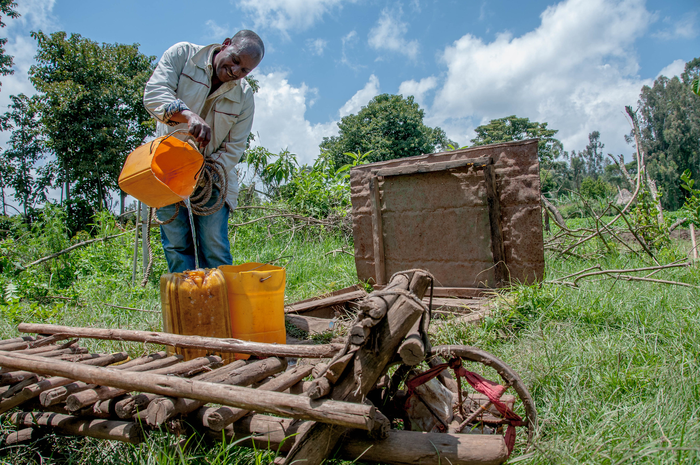The organic matter in the Earth’s soils can store more than twice the carbon compared to atmospheric CO2. Therefore, deciphering the carbon sequestration potential of various agricultural practices and landscapes is considered essential in meeting the national and global climate goals.
 A farmer draws water from a well in Hosana, Ethiopia. Image Credit: Georgina Smith.
A farmer draws water from a well in Hosana, Ethiopia. Image Credit: Georgina Smith.
Generally, when people think about carbon sequestration, they think about just planting trees on the surface, but really if we can quantify how much the soil can help in sequestering, then we can develop effective soil management strategies and our carbon sequestration targets.
Wuletawu Abera, Study Corresponding Author, International Center for Tropical Agriculture
The research team guided by Abera at the Alliance of Bioversity International and the International Center for Tropical Agriculture (CIAT) and their colleagues have demonstrated that integrating the vegetation cover with earthworks, like holding trenches or walls, can help boost the carbon quantity stored in the soil.
Three studies returned these results. The first one analyzes the historical carbon sequestration of various land uses in the Ethiopian highlands, the second one analyzes the effect of different ways of managing land, especially in agricultural or degraded landscapes and the third proposes future scenarios depending on modeling.
In recent decades, the Ethiopian highlands — a huge, mountainous region of East Africa — have witnessed significant degradation of land. This is due to the replacement of tree cover by agricultural land, which leads to steep slopes and high rainfall, resulting in erosion and the absence of soil organic matter. This is why Abera feels that it is crucial to offer strong proof of how land-use change causes an effect on the amount of carbon confined in the soil.
In a study published in the Agriculture, Ecosystems & Environment journal in 2020, Abera and his group revealed the outcomes of 241 topsoil samples, analyzing data of over eight decades to offer a historical point of view.
The researchers have discovered that the soil occupied by undisturbed vegetation and guarded guasa grasslands consists of the highest stored soil carbon.
The dominant values are the soil properties like clay and soil PH and vegetation cover. As well as being a carbon sink itself, vegetation has many functions, including ground cover, preventing erosion and promoting the growth of microorganisms.
Wuletawu Abera, Study Corresponding Author, International Center for Tropical Agriculture
In the new study, Abera and a different group of study co-authors concentrated on what land management practices and landscapes generated the best results for retaining the soil carbon. The study was published in the May 2021 edition of the Journal of Environmental Management.
According to Abera, the combination of vegetation cover and building physical structures, such as retaining walls and trenches, was highly successful in raising the amount of organic carbon stored in the soil.
“The higher the soil carbon, the better the retention of water and nutrients, making for better soils for agriculture,” Abera said, adding that the biggest benefits were found in lightly or moderately disturbed areas.
Both studies performed took parts of the highlands into account where a national land management campaign has been in progress. The scientists have joined hands with the Ethiopian Ministry of Agriculture, believing that this strong proof can be utilized to assist the deployment of land management methods over the country’s 135 significant watersheds by the sustainable land management program conducted by the Ministry of Agriculture.
“Our findings confirm that we can practice good land management: we have evidence that can guide government actions and ultimately sequester more carbon,” stated Abera, adding that he believed that these lessons would make other countries take similar efforts.
The focus of the third study, reported in July 2021, in the journal Environment, Development and Sustainability, was on modeling and mapping soil carbon sequestration from various enhanced land management practices. Abera notes how his background has been a factor that has informed the research.
I’m from the countryside and my family are farmers, so as a boy I used to support my father when he was farming.
Wuletawu Abera, Study Corresponding Author, International Center for Tropical Agriculture
All farmers are not conscious of the mechanics of carbon sequestration. However, Abera states that they have better insights into the practical benefits of the land management practices, despite the fact that such practices do not often result in high agricultural yields in a short period.
Abera holds a PhD degree in hydrology and he initially concentrated on water management and irrigation, stating that the carbon work is especially satisfying.
“It makes me happy, it connects me to my roots and produces the evidence needed to help on a global scale,” stated Abera.
Journal Reference:
Abera, W., et al. (2021) Estimating spatially distributed SOC sequestration potentials of sustainable land management practices in Ethiopia. Journal of Environmental Management. doi.org/10.1016/j.jenvman.2021.112191.